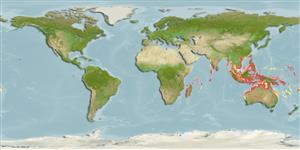Elasmobranquios (tiburones y rayas) (sharks and rays) >
Carcharhiniformes (Ground sharks) >
Carcharhinidae (Requiem sharks)
Etymology: Carcharhinus: karcharos (Gr.), sharp or jagged; rhinus, an ancient name for sharks, from rhine (Gr.), rasp, both words alluding to a shark's jagged, rasp-like skin (See ETYFish); sealei: In honor of American ichthyologist Alvin Seale (1871-1958), Stanford University, who described this shark in 1910 but used a preoccupied name (C. borneensis) (See ETYFish).
Eponymy: Alvin Seale (1871–1958) was an ichthyologist and designer of aquaria. [...] (Ref. 128868), visit book page.
Environment: milieu / climate zone / depth range / distribution range
Ecología
marino asociado a arrecife; rango de profundidad 0 - 40 m (Ref. 244). Tropical; 24°N - 30°S
Indo-West Pacific: reported to occur throughout the area, from Kenya to Indonesia; north to China. Distribution west of the Indo-Malay Peninsual needs validation.
Length at first maturity / Tamaño / Peso / Age
Maturity: Lm 71.5, range 68 - 75 cm
Max length : 100.0 cm TL macho / no sexado; (Ref. 3678); 84.6 cm TL (female)
A small species which is distinguished by the following characters: snout moderately long and bluntly pointed; upper anterior teeth oblique and blade-like, coarsely serrated laterally, lateral margin deeply notched and with several large and smooth basal cusplets; lower anterior teeth narrower, slightly oblique, lateral margins usually not notched and with several large basal serrae, mostly smooth; total tooth row 24-28/22-27 or 47-55; interdorsal space often without a ridge on midline, 19.0-22.4% TL; first dorsal fin is moderately tall and falcate, origin about opposite pectoral-fin free rear tip, length 14.7-16.0% TL, 1.3-1.7 times height, inner margin 2.1-2.7 in base; second dorsal fin is much smaller, broadly triangular, height 31-37% of first dorsal fin height, its origin slightly posterior to anal-fin origin; anal fin falcate, height 0.9-1.2 times second dorsal height, base 1.0-1.3 times second dorsal-fin base; body colour pale brownish to grey dorsally, whitish ventrally; second dorsal fin with a black blotch covering most of fin and often extending slightly onto upper surface of body, usually diffuse-edged and poorly defined from ground colour of fin; other fins are plain or with pale outer margins; total vertebral 146-163; monospondylous precaudal 42-48; diplospondylous precaudal 26-38; diplospondylous caudal 74-81; precaudal 71-82 (Ref. 89954).
Found on the continental and insular shelves, from the surf line and intertidal region to deeper water (Ref. 244). Feeds on small bony fishes (including sea horses), prawns, and squid (Ref. 9997). Viviparous (Ref. 50449). Specimens caught with size ranging from 37.0-67.4 cm TL were found to be immature, males apparently begin to mature around 71.0 cm TL and birth size is between 32.0 and 37.0 cm TL (Ref. 89954). Often caught by shore anglers (Ref. 5485). Utilized as a food fish (Ref. 244).
Viviparous, with a yok-sac placenta; 1-2 pups per litter (Ref. 244); after a gestation period of ~ 9 months(Ref.58048). 33-45 cm TL at birth (Ref. 9997). Distinct pairing with embrace (Ref. 205).
White, W.T., 2012. A redescription of Carcharhinus dussumieri and C. sealei, with resurrection of C. coatesi and C. tjutjot as valid species (Chondrichthyes: Carcharhinidae). Zootaxa 3241:1-34. (Ref. 89954)
IUCN Red List Status (Ref. 130435: Version 2024-1)
Human uses
Pesquerías: comercial; pesca deportiva: si
Herramientas
Special reports
Download XML
Fuentes de Internet
Estimates based on models
Preferred temperature (Ref.
123201): 24.9 - 29.1, mean 28.2 °C (based on 1150 cells).
Phylogenetic diversity index (Ref.
82804): PD
50 = 0.5000 [Uniqueness, from 0.5 = low to 2.0 = high].
Bayesian length-weight: a=0.00417 (0.00204 - 0.00851), b=3.07 (2.91 - 3.23), in cm total length, based on LWR estimates for this species & Genus-body shape (Ref.
93245).
Nivel trófico (Ref.
69278): 4.2 ±0.4 se; based on diet studies.
Resiliencia (Ref.
120179): Muy bajo, población duplicada en un tiempo mínimo superior a 14 años (Fec=1).
Fishing Vulnerability (Ref.
59153): High vulnerability (60 of 100).
Nutrients (Ref.
124155): Calcium = 11.3 [2.2, 59.9] mg/100g; Iron = 0.466 [0.118, 1.294] mg/100g; Protein = 22.1 [19.4, 24.4] %; Omega3 = 0.109 [0.045, 0.251] g/100g; Selenium = 22.9 [6.0, 62.6] μg/100g; VitaminA = 72.1 [27.9, 181.4] μg/100g; Zinc = 0.669 [0.319, 1.284] mg/100g (wet weight);
